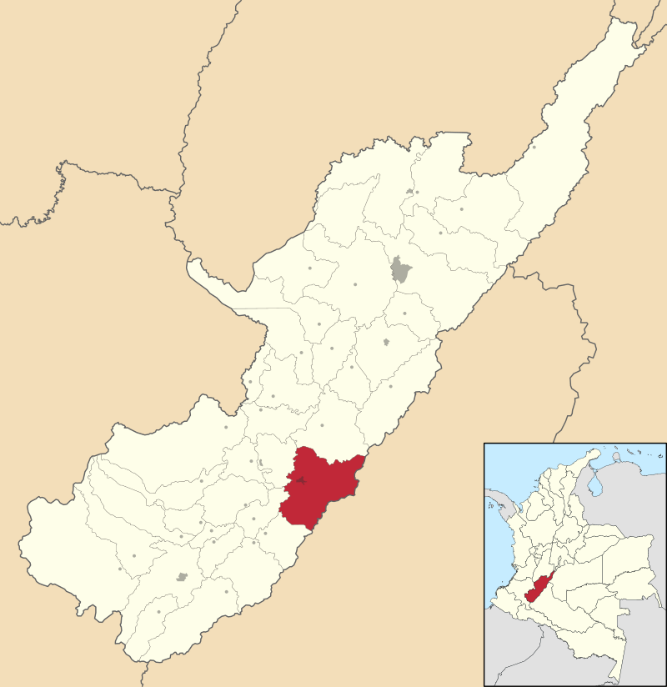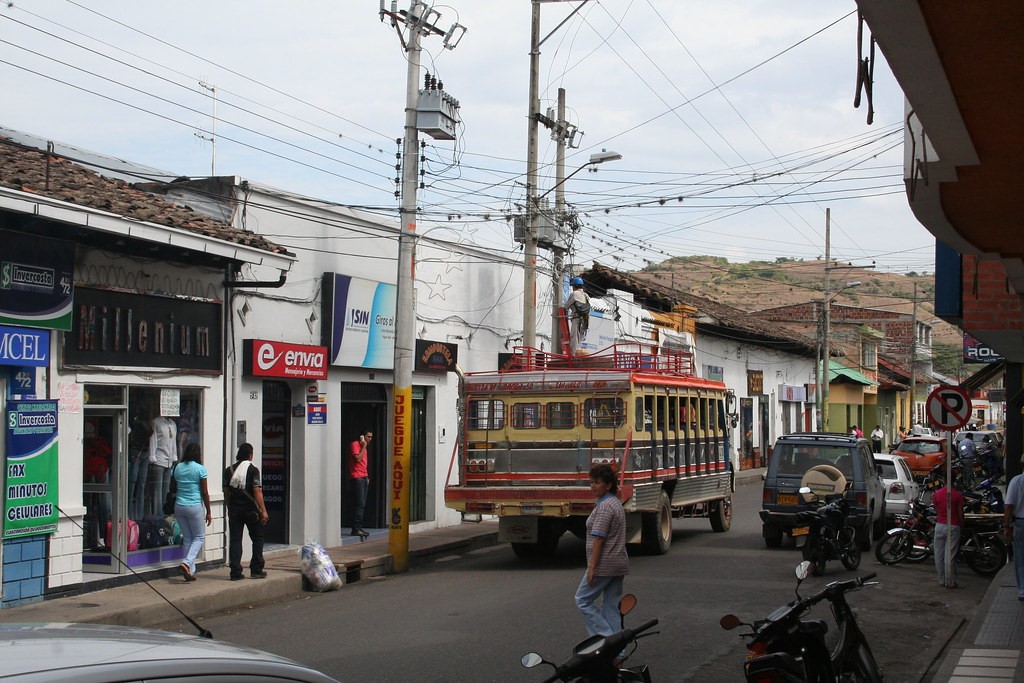GARZON
Department
Huila Department, Colombia

Flag of the city
The Flag of the Municipality of Garzón is composed of a rectangle in a 2:3 proportion, which is divided into three triangles, two of them rectangles and one isosceles. The first right triangle is white. With the right angle it forms the upper left corner of the flag, reaching with its short side to the midpoint of the width of the flag and with its acute angle touching the upper right corner. El Blanco is a symbol of the purity and honesty of the Garzoneño people, as a reflection of the spiritual greatness of its people. The second triangle is isosceles, having its base on the right side of the flag throughout the entire extent of its width and fixing its point at the midpoint of the width on the left side. It is the largest area of the flag. Yellow is a symbol of the wealth and strength of the Garzoneno people, industrious and enterprising with immense agricultural potential given the diversity of thermal floors. The third right triangle is green. With the right angle it forms the lower left corner of the flag, reaching with its short side to the midpoint of the width of the flag and with its acute angle touching the lower right corner. Green means Garzoneño’s hope and commitment to natural resources, for the preservation and conservation of the environment. The proposal for the adoption of the flag of the municipality of Garzón was presented by the Honorable Councilor Hernán Valderrama.

Seal of the city

Slogan of the city
Garzón is known as the Diocesan Capital of Huila and is the first Catholic diocese in the region. The nickname “the Soul of Huila” suggests a cultural and spiritual significance for the city. Given this context, it reflects the importance of Garzón not only as a geographical and administrative center but also as a hub for religious and cultural activities within the Huila region. The emphasis on religious architecture and culture further underscores the city’s rich heritage and the role it plays in preserving and promoting the cultural identity of the area.
History

The town of Garzón traces its roots back to approximately 1775 when Don Vicente Manrique de Lara generously donated lands for its establishment. By 1783, the settlement, initially known as “Garzoncito,” was officially founded. Progressing swiftly, on January 1, 1788, Garzon achieved municipality status, and by 1810, it proudly earned the title of Villa. On May 19, 1825, it was designated as the head of the Canton of Timaná and eventually became the capital of the southern province of Colima. While the area had long been recognized by the name “Garzoncito,” the diminutive was dropped upon the town’s formal establishment, giving it the name it bears today. Historians recount that the name’s origin dates back to the Spanish colonization, associating it with a formidable bird, the Garzón, believed to be a large heron species. This creature, known for its aggressiveness, appeared briefly before disappearing. The settlers, in response, named the river in the region “Garzón,” supplanting the previous name of Tocheré.
Garzón has been a birthplace and residence for notable individuals contributing to art, culture, and politics. Yesid Morales Ramírez, a painter and poet, proudly hails from Garzón. The sculptor Emiro Garzón resides in La Jagua, a village within Garzón. Pablo Emilio Figueroa Urriago, a Colombian citizen, founded bambuco music and folkloric festivals in the town, along with establishments like the traditional Café Minino. Currently known as Café Roxy, the café still occupies its original location in Plaza de Bolívar and is affectionately referred to as “El Minino” by its patrons, in homage to its founder’s great humor. Among the literary figures associated with Garzón are Antonio Iriarte Cadena, Amadeo González Treviño, and Diego Calle Cadavid, as well as Hamilton Benedicto Lizcano Parra. The municipality has also witnessed the achievements of women, with Irma Vargas Cadena becoming the first female doctor in the city, and her sister Ángela Constanza Vargas Cadena (Angie McCallum) earning the distinction of being the first female Petroleum Engineer. In the realm of politics, Senator Ernesto Macías Tovar, known for his opposition to peace talks with the FARC and post-conflict initiatives, was born in Garzón. The city has seen its share of political dynamics, with figures like Jaime Bravo Motta and Edgar Bonilla Ramírez serving as mayors amidst investigations into their administrative actions concerning public funds, particularly those allocated for healthcare and the recreational center Manila.
Geography of the city
Nestled within a vast expanse of 606.5 km², Garzón, a municipality and town of captivating beauty, unfolds across the landscape at an elevation of 828 meters (2,717 feet). The urban heart, encompassing 5.22 km², weaves its tales amidst the larger tapestry of this Colombian haven. As of the 2020 estimate, 74,136 souls call Garzón home, cultivating a density of 120 individuals per square kilometer, while the urban hub boasts a population of 39,544 with an urban density that pulsates at 7,600 residents per square kilometer. This haven in the southwestern embrace of Colombia, known for its mild climate, dances with nature’s rhythm. The symphony of seasons unfolds in a ballet of rain and sunshine, with the winter season, a cascade of rain, serenading the town in the months of March, April, and May. Conversely, the summer season, basking in warmth, graces the remaining months, particularly November, December, and January, where temperatures ascend to a harmonious 30 °C. Garzón, cradled between the Magdalena and Suaza rivers, and adorned with a network of minor rivers — Agua Caliente, Caguancito, Cara de Perro, Damas, Garzoncito, Pescado, and Río Loro — breathes life into its geographical narrative. These waterways, more than mere ribbons across the land, are the arteries that sustain the town’s vitality, contributing to both the ecological equilibrium and the economic pulse of the community.

Population
Municipality and town 74,136 (2020)
Urban 39,544 (2020)
One photo representative of the city

Etymology
The etymology of the name “Garzón” traces its roots to historical and cultural contexts, offering insights into the origin and significance of the term. In the case of Garzón, historians and linguists suggest that the name finds its inspiration in the Spanish language. The town’s designation is believed to be associated with a specific bird species, the “garzón.” This bird, recognized as a large heron, was notable for its aggressive nature. According to historical accounts, during the Spanish colonization of the region, settlers encountered this impressive heron, which appeared briefly before disappearing from the local landscape. The settlers, in response to this encounter, bestowed upon the bird the name “Garzón.” In this context, the town derived its name from the Spanish word “garzón,” referring to this majestic and formidable heron. Over time, as the settlement grew and developed, the name became ingrained in the local culture and history, shaping the identity of the town.
What the city is known or famous for

Garzón’s fame revolves primarily around agriculture, featuring a diverse range of products that contribute to its prosperity. The cultivation of coffee, cacao, and various fruits plays a central role in shaping the agricultural landscape of the municipality. Additionally, livestock farming is a significant component, reflecting the region’s commitment to animal husbandry. The town’s economic tapestry also includes fish farming, emphasizing the importance of aquatic resources in sustaining local livelihoods. This sector not only provides a source of income but also contributes to the overall economic stability of Garzón. Garzón’s agricultural output, including its famed coffee and cacao, finds its way to markets beyond the municipal borders. The products from Garzón are distributed and sold in prominent cities such as Neiva and Bogotá. This not only enhances the municipality’s economic reach but also underscores the quality and desirability of its agricultural products on a larger scale. The agricultural and fish farming activities in Garzón not only contribute to the local economy but also highlight the town’s role in the broader agricultural landscape of the region. The market presence in Neiva and Bogotá signifies the town’s participation in regional trade networks, showcasing its products to a wider consumer base.
